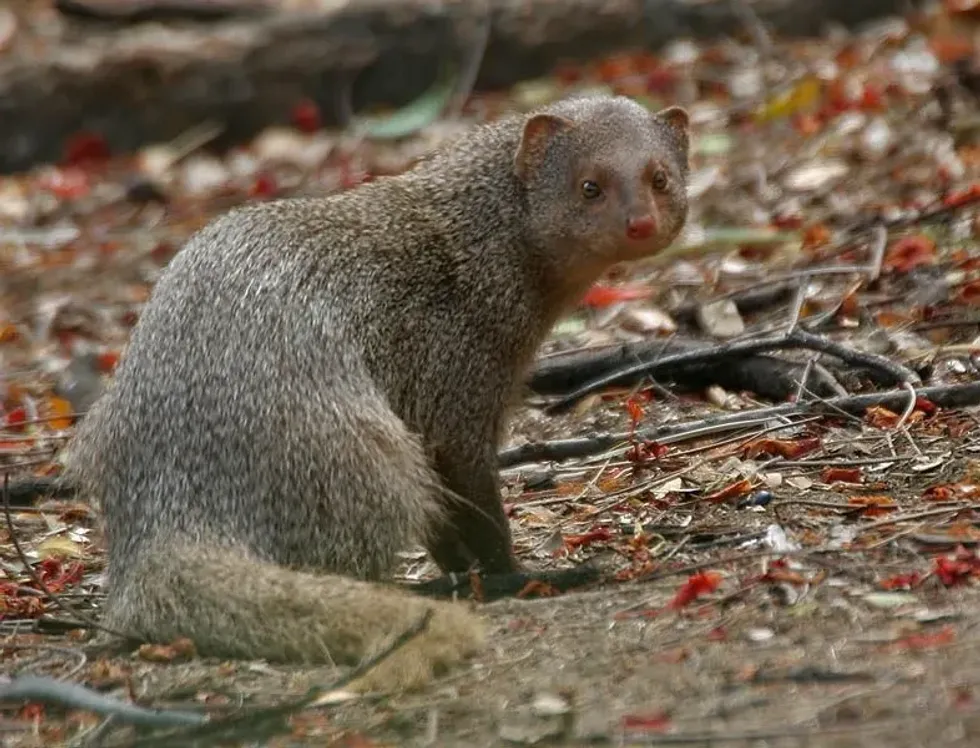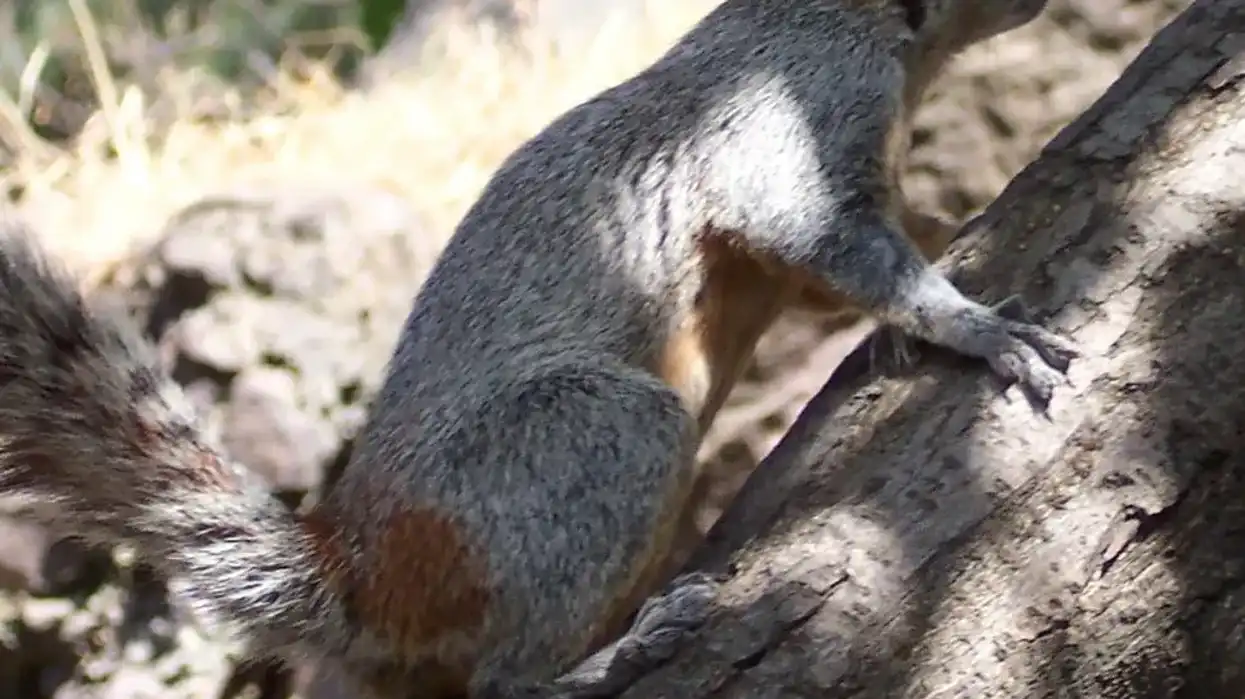Indian grey mongoose (Herpestes edwardsii) is a pointy faced little furry animal with a bushy tail. However, they have traits similar to other rodents; they are not actually rodents.
They are terrestrial and diurnal solitary hunters by nature. Though common grey mongoose, like other species of mongoose, can usually be seen throughout the day, Herpestes edwardsii is generally found hunting for reptiles during the early morning or the early evening.
Indian mongoose is believed to be one of the biggest natural nemeses of snakes like Cobras. They are known for their aggressive actions and fierce fighting skills.
Though an Indian grey mongoose is not poisonous themselves, a scorpion's venomous sting can not harm them. Local families often keep them as pets for their exceptional fighting skills that keep their houses free of rats and other pests.
Indian Grey Mongoose Interesting Facts
What type of animal is an Indian grey mongoose?
Indian grey mongoose (Herpestes edwardsii) are small mongoose belonging to the family of Herpestidae.
What class of animal does an Indian grey mongoose belong to?
The Indian gray mongoose belongs to the Mammalia class of our animal kingdom.
How many Indian grey mongooses are there in the world?
The exact population range of the Indian gray mongoose (Herpestes edwardsi) is still not accounted for. However, they are prevalent throughout their distribution range. Studies have also shown that they are constantly moving away from highly populated areas and into more undisturbed forests.
Where does an Indian grey mongoose live?
The Indian gray mongoose is distributed through Iran, Afghanistan, Bahrain, Pakistan, India, Nepal, Bhutan, Bangladesh, Kuwait, Saudi Arabia, Sri Lanka, Turkey, and the United Arab Emirates.
According to the recent studies by The IUCN Red list, the Indian gray mongoose is possibly Extinct in Malaysia.
The usual elevation limit of an Indian gray mongoose is up to 8202 ft (2,500 m).
What is an Indian grey mongoose's habitat?
The Herpestes edwardsii mostly feeds on wild lizards, snakes, and other insects; they tend to stay mostly in forests. Studies have shown Indian gray mongoose habitat in bushy vegetation, cultivated fields, and thickets to keep themselves hidden from sudden attacks from predator snakes like a constrictor or a pitviper.
They dig their own holes and stay underground to avoid any direct sunlight.
Who do Indian grey mongooses live with?
The Indian grey mongoose does have a term when sometimes they travel in groups, called mongeese or mongaggle. However, they spend most of their time searching for a snake or other animals to prey on alone in solitary.
How long does an Indian grey mongoose live?
The average life span range of an Indian grey mongoose is approximately seven years in the wild, but as a pet or when in captivity, their average life expectancy goes up to 11-12 years.
How do they reproduce?
The long furry species of Indian grey mongoose (herpestes edwardsi) is mostly known for its solitary nature. It looks for mates only during their mating season in March, August, and October.
As they are polygynous, they soon get separated from their mates right after mating, and male mongooses search for other mates. The gestation period of female mongooses ends by the end of May or June and then from October to December.
Usually, in a single cycle, the female mongooses give birth to two to four pups. The pups after birth remain helpless and blind; their mother keeps her babies close to them and protects them for about six months. The pups gain maturity after six to nine months after their birth and become independent.
What is their conservation status?
The IUCN Redlist had declared the species of mongoose as Least Concern as they can be found easily in their habitat, and their population trend is stable at this moment.
Indian Grey Mongoose Fun Facts
What does an Indian grey mongoose look like?
The species of Indian grey mongoose have a long furry body, a pointy face, and very short legs. The Herpestes edwardsi have coarse and very thick textured coats with a white tipped tail. Their tail alone has a length of 13.7 in (0.35 m).
Besides having a distinctive tail from other mongooses, this species of Indian grey mongoose also has distinctive silver gray and pepper speckled fur.
The common Indian grey mongoose has five toes on both their hindfoot and their forefoot. However, the forefoot of this species of mongoose has sharp claws and is covered in fur; their hind legs remain completely naked.
They use these claws to fight snakes. Whenever mongooses engage in a fight with a snake, mongooses end up crushing the snake's skull with their claws and their teeth.

How cute are they?
It is very natural to find Indian grey mongooses cute for their small body structure. Though they are very fearsome and wild, they are also charming.
Especially in India, mongooses are considered adorable species.
How do they communicate?
As Indian grey mongoose mostly lives in solitary, very little information is available on how an Indian grey mongoose communicates with its own species.
The species of mongoose use an anal sac for communication; even that is used only during their mating season, they deposit the spray at a nose level on vertical objects.
Male mongooses raise one leg to urinate and mark objects.
This common grey mongoose species might also spray on higher objects by rearing up their forepaws, getting into a handstand position, and then letting out the secretion.
How big is an Indian grey mongoose?
The common grey mongoose, also called Indian grey mongoose, has a combined length of 14-17.7 in (0.36-0.45 m), which includes the length of their body and their head. The tail of an Indian grey mongoose is approximately 13.7 in (0.35 m) long.
Compared to other species of mongoose like the dwarf mongoose, which has a length of 7-12 in (0.17-0.30 m), the Indian grey mongoose appears to be almost double in size.
However, if we compare the species of Indian gray mongoose vs king cobra, where a King Cobra has a length of about 224 in (5.71 m), the Indian gray mongoose will look like a tiny pebble in front of the giant snake.
How fast can an Indian grey mongoose run?
The highest estimated speed of an Indian gray mongoose is 19.8 mph (32 kph). They are very agile and can climb up trees very fast.
How much does an Indian grey mongoose weigh?
The average weight of this species is approximately 1.9-3.7 lb (0.9-1.7 kg)
What are the male and female names of the species?
This species, unfortunately, has no specific term to distinguish between a male and a female mongoose.
What would you call a baby Indian grey mongoose?
The newborn Indian gray mongoose is called a pup.
What do they eat?
The Indian gray mongoose is an omnivore by nature, and its diet consists of small birds, birds that dwell on the ground, lizards, and other invertebrates. They love to prey on a snake and sometimes eat the eggs of birds.
Being an omnivore, their diet also includes fruits, berries, and roots. They do not rely on climbing trees to fetch their food.
Are they poisonous?
The Indian gray mongoose (Herpestes edwardsii) is vicious and wild. They are known for their extraordinary fighting skills and ability to kill poisonous animals, but they are not poisonous themselves.
Would they make a good pet?
The species is definitely considered a good pet in various parts of the world. They help their owners keep their houses free of pests.
Did you know...
The evergreen short story on Indian gray mongoose pet called Rikki Tikki Tavi popularised the Indian mongoose.
Though we do not usually see the population generally engaging in climbing trees, they get everything in their diet from the ground itself, diminishing their need to climb trees.
How many types of mongoose are there?
There are 34 species of mongoose divided into 20 genera.
Are Indian grey mongooses endangered?
No, there is no possibility for the Indian gray mongooses to get extinct soon.
Here at Kidadl, we have carefully created lots of interesting family friendly animal facts for everyone to discover! For more relatable content, check out these mongoose facts and banded mongoose facts pages.
You can even occupy yourself at home by coloring in one of our free printable mammals coloring pages.
Main image and second image by J.M.Garg.









